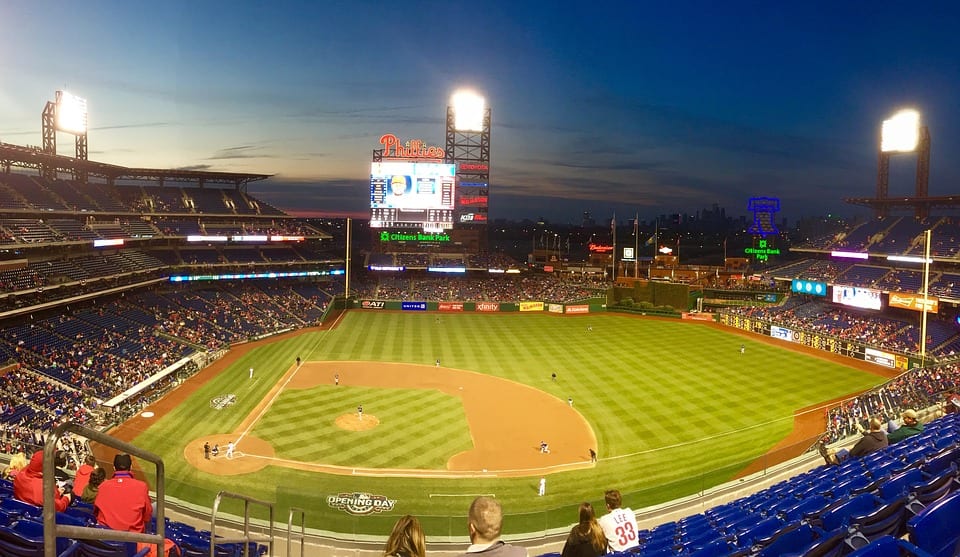After ESPN released the 2017 MLB Attendance Report, several sports news outlets were quick to address the league’s steady decline that slumps off this year with the lowest attendance total since 2003 at 72.67 million.
Ten years ago in 2007, the MLB saw an attendance peak at 79.5 million. Two years later, attendance topped at just over 73m. It rose again to 75m in 2012, but has stayed between 73-75m for the past five years until falling below that mark for 2017.
This year’s attendance total fell 8.59% from one decade ago and 0.67% from last year.
It’s not a bad year-over-year decrease, but it does continue a long trend line in MLB attendance. And these numbers may worse than the report lets on. That’s because attendance numbers are measured by the seats that have been paid for, not the seats that are physically filled, at each game. If ballparks keep count of turnstile clicks, they certainly don’t release that data – and haven’t since 2000.
This discrepancy, though it can’t be definitively quantified, is no small mark given the increasing availability and popularity of subscription-based ticket pass products. Two years ago, only four of the 30 MLB teams offered these kinds of packages. This year, twenty-three teams did.
Ballpark Digest highlighted a few of these innovative pass products before the start of the 2017 season. A few examples: St. Louis Cardinals offer fans to attend as many games in one month as they wish for $29.99; Houston Astros did the same for the month of April for $59; $50 will buy a Phillies fan any 11 spring home games; the New York Yankees Pinstripe Pass even throws in a free beer with your standing-room access for $15 (most of these packages do include stipulations that exclude Opening Day, limits rivalry games, and/or forbids ticket transfer).
Season ticket packages are expected to expand even more in seasons to come, including opportunities for more in-demand seats beyond standing room access and upper-level sections.
The benefit of these products: guaranteed immunity from price inflation for the most popular games. Their downside: paying for weekday games, games during inclement weather, and games you otherwise just can’t or don’t want to attend.
The most telling evidence available to infer MLB no-show rates are simply the view of the stadium at any given game – several of which have made headlines and social media posts this season for their grim emptiness.
I'm doing the baseball thing today. The stadium is literally empty. #thesteelersareon pic.twitter.com/vL5s78JvT5
— Caitlin McCullough (@CaityLove) September 24, 2017
BEAUTIFUL night for a game between the two best teams in baseball on nat'l TV.
So why are the seats so empty. #rhetorical@EmptySeatsPics pic.twitter.com/grF4fQ0wyu
— Church of Sell the Team, Bobo ⚾ (@churchofbasebal) September 18, 2017
https://twitter.com/rolandsghost/status/895528739890761728
Trends in the secondary marketplace can be proof of ill-attended baseball games, as well. Tickets are resold below face value by season ticket holders for any of the aforementioned reasons, as well as by brokers who took a risk on teams whose fate didn’t fare the way they’d hoped. In these cases, ticket prices can plummet to as low as the price of a beer at the ballpark just so sellers can get them off of their hands at less than a complete loss.
Russ Stanley, managing vice president of ticket sales and service for the San Francisco Giants (#3 highest attendance in 2017) talked to Sports Business Journal about the MLB’s slipping attendance. “We have a lot of competition out there,” Stanley said. “We’re all battling for fans’ attention, and they have a lot of things pulling on them.” His solution?
“We are constantly adding new programs to get more people involved and coming through the ballpark, particularly kids. And beyond solidifying our season-ticket base, this will be a key area of focus.”
We can safely assume expanding the season-ticket base will not lead to greater actual attendance at games, though developing more appealing or affordable packages may help with what numbers are announced to the public. With the greatest ticket inventory of any sport, and traditionally being reliable on ticket sales as the greatest source of revenue, will baseball be able to reverse the steady decline of its attendance trend?


